Medication Management in Social Care: Legislation, Roles and Protocols
VerifiedAdded on 2020/06/06
|9
|2281
|49
Report
AI Summary
This report provides a comprehensive overview of medication handling within social care settings. It begins by outlining current legislation and policies, including the Medicines Act 1968, the Health Act 2006, and the Misuse of Drugs Act 2001. The report then details the roles and responsibilities of individuals involved in medication support, such as nurses and managers, and the importance of proper communication. It further explores the various methods of accessing medication information, including Medication Administration Records (MAR), care plans, and medical records. The report also covers different routes of medication administration (oral, inhalation, injection, etc.), various forms of medication presentation (solid, liquid, gas, topical), and the equipment used in medication administration. The report emphasizes the importance of accurate data recording using MAR sheets, care records, and controlled drug books. It also covers the safe storage and disposal of medications, adhering to COSHH regulations and medicine take-back programs, concluding that proper medication management is crucial for the health and well-being of patients in social care settings.
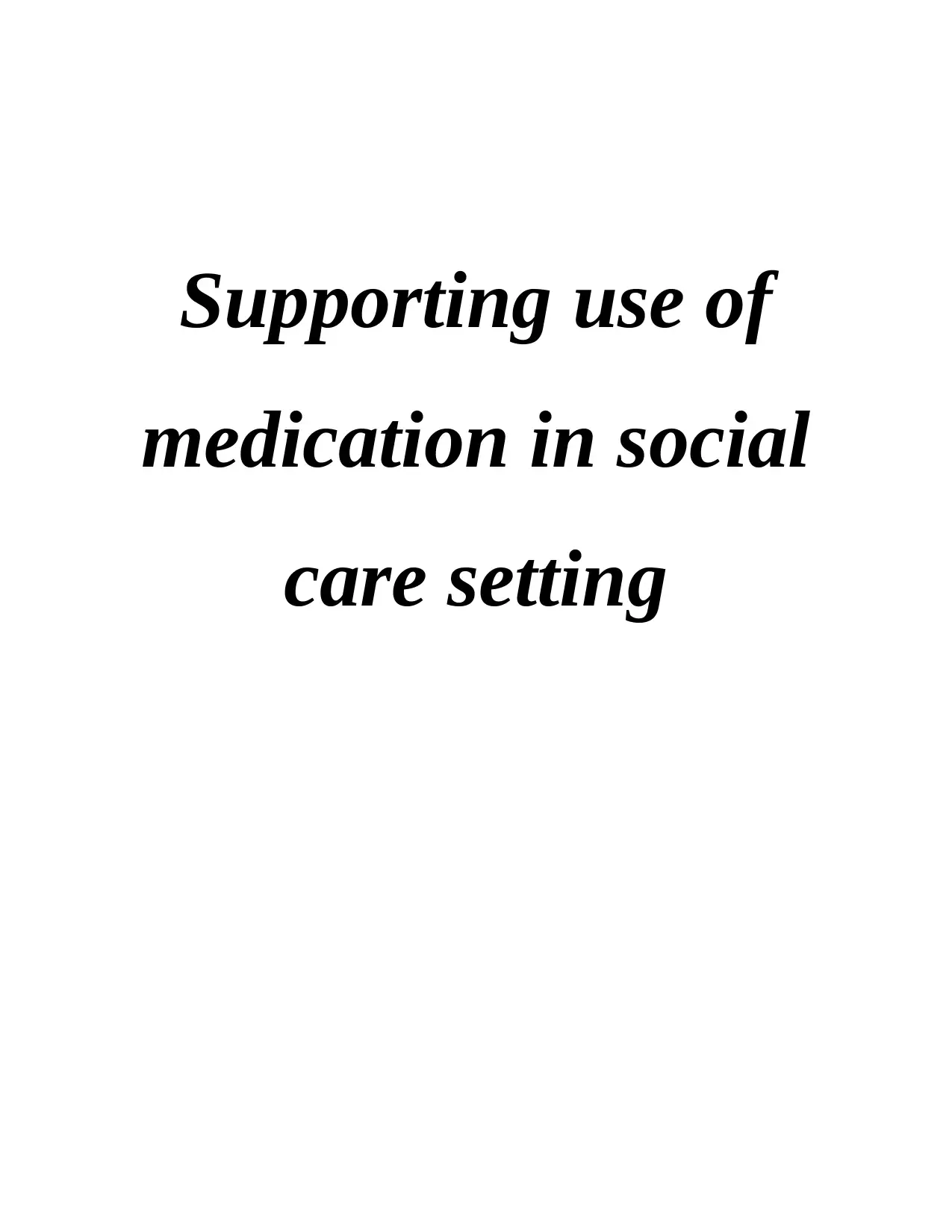
Supporting use of
medication in social
care setting
medication in social
care setting
Paraphrase This Document
Need a fresh take? Get an instant paraphrase of this document with our AI Paraphraser

Table of Contents
INTRODUCTION...........................................................................................................................1
TASK 1............................................................................................................................................1
P1 Current legislation and policy for handling of medication in social care settings.................1
TASK 2............................................................................................................................................1
P2 Roles and responsibilities of individuals who support the use of medication.......................1
TASK 3............................................................................................................................................2
P3 Access of information involved in medication......................................................................2
P4 Routes to administer the medication......................................................................................2
P5 Various forms to present the medication...............................................................................3
P6 Assist the equipment in administration of medication...........................................................3
TASK 4............................................................................................................................................3
P7 Data that must be recorded about the use of medication.......................................................3
P8 Safe storage of various medications......................................................................................4
P9 Dispose of unused medications safely...................................................................................4
CONCLUSION................................................................................................................................5
REFERENCES................................................................................................................................5
.........................................................................................................................................................5
INTRODUCTION...........................................................................................................................1
TASK 1............................................................................................................................................1
P1 Current legislation and policy for handling of medication in social care settings.................1
TASK 2............................................................................................................................................1
P2 Roles and responsibilities of individuals who support the use of medication.......................1
TASK 3............................................................................................................................................2
P3 Access of information involved in medication......................................................................2
P4 Routes to administer the medication......................................................................................2
P5 Various forms to present the medication...............................................................................3
P6 Assist the equipment in administration of medication...........................................................3
TASK 4............................................................................................................................................3
P7 Data that must be recorded about the use of medication.......................................................3
P8 Safe storage of various medications......................................................................................4
P9 Dispose of unused medications safely...................................................................................4
CONCLUSION................................................................................................................................5
REFERENCES................................................................................................................................5
.........................................................................................................................................................5

⊘ This is a preview!⊘
Do you want full access?
Subscribe today to unlock all pages.

Trusted by 1+ million students worldwide
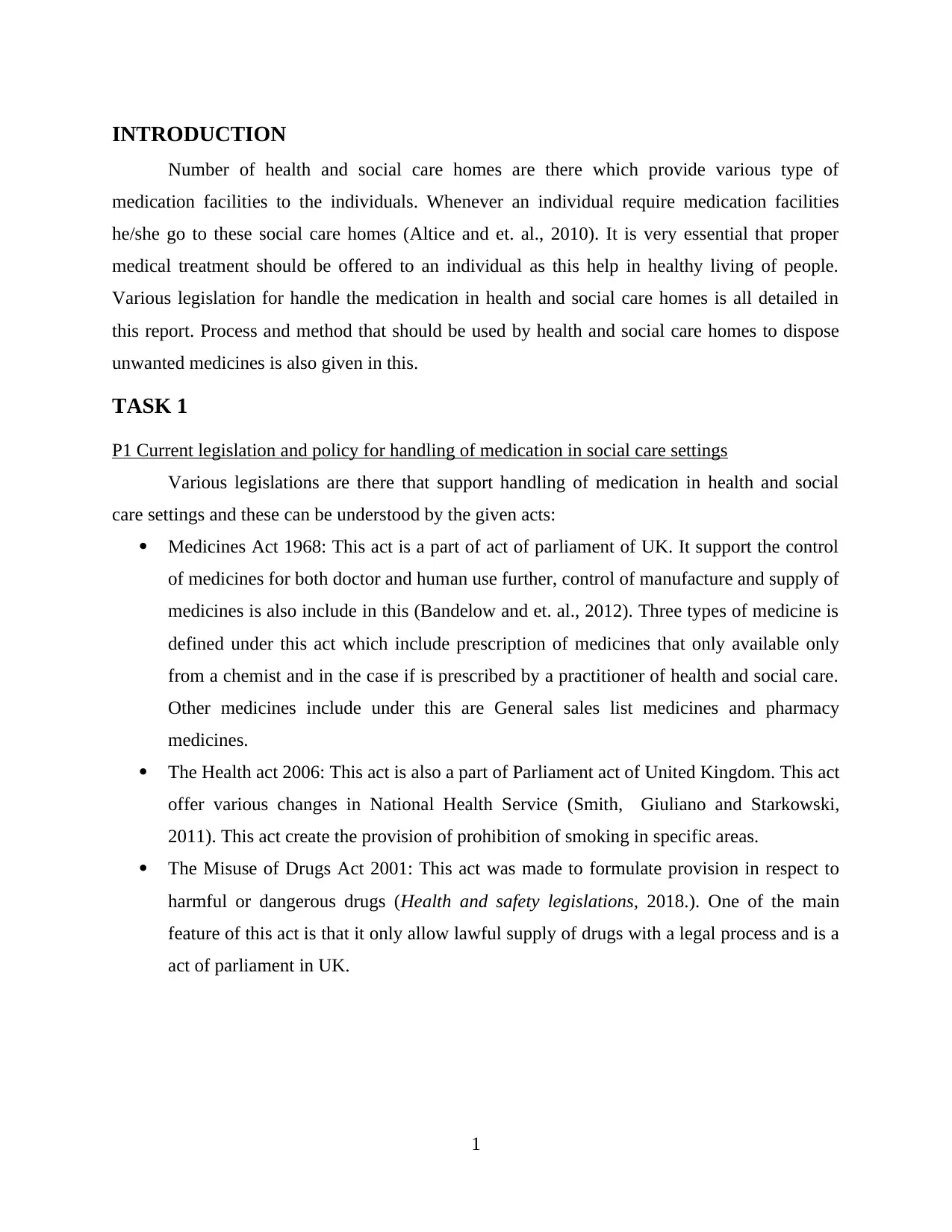
INTRODUCTION
Number of health and social care homes are there which provide various type of
medication facilities to the individuals. Whenever an individual require medication facilities
he/she go to these social care homes (Altice and et. al., 2010). It is very essential that proper
medical treatment should be offered to an individual as this help in healthy living of people.
Various legislation for handle the medication in health and social care homes is all detailed in
this report. Process and method that should be used by health and social care homes to dispose
unwanted medicines is also given in this.
TASK 1
P1 Current legislation and policy for handling of medication in social care settings
Various legislations are there that support handling of medication in health and social
care settings and these can be understood by the given acts:
Medicines Act 1968: This act is a part of act of parliament of UK. It support the control
of medicines for both doctor and human use further, control of manufacture and supply of
medicines is also include in this (Bandelow and et. al., 2012). Three types of medicine is
defined under this act which include prescription of medicines that only available only
from a chemist and in the case if is prescribed by a practitioner of health and social care.
Other medicines include under this are General sales list medicines and pharmacy
medicines.
The Health act 2006: This act is also a part of Parliament act of United Kingdom. This act
offer various changes in National Health Service (Smith, Giuliano and Starkowski,
2011). This act create the provision of prohibition of smoking in specific areas.
The Misuse of Drugs Act 2001: This act was made to formulate provision in respect to
harmful or dangerous drugs (Health and safety legislations, 2018.). One of the main
feature of this act is that it only allow lawful supply of drugs with a legal process and is a
act of parliament in UK.
1
Number of health and social care homes are there which provide various type of
medication facilities to the individuals. Whenever an individual require medication facilities
he/she go to these social care homes (Altice and et. al., 2010). It is very essential that proper
medical treatment should be offered to an individual as this help in healthy living of people.
Various legislation for handle the medication in health and social care homes is all detailed in
this report. Process and method that should be used by health and social care homes to dispose
unwanted medicines is also given in this.
TASK 1
P1 Current legislation and policy for handling of medication in social care settings
Various legislations are there that support handling of medication in health and social
care settings and these can be understood by the given acts:
Medicines Act 1968: This act is a part of act of parliament of UK. It support the control
of medicines for both doctor and human use further, control of manufacture and supply of
medicines is also include in this (Bandelow and et. al., 2012). Three types of medicine is
defined under this act which include prescription of medicines that only available only
from a chemist and in the case if is prescribed by a practitioner of health and social care.
Other medicines include under this are General sales list medicines and pharmacy
medicines.
The Health act 2006: This act is also a part of Parliament act of United Kingdom. This act
offer various changes in National Health Service (Smith, Giuliano and Starkowski,
2011). This act create the provision of prohibition of smoking in specific areas.
The Misuse of Drugs Act 2001: This act was made to formulate provision in respect to
harmful or dangerous drugs (Health and safety legislations, 2018.). One of the main
feature of this act is that it only allow lawful supply of drugs with a legal process and is a
act of parliament in UK.
1
Paraphrase This Document
Need a fresh take? Get an instant paraphrase of this document with our AI Paraphraser
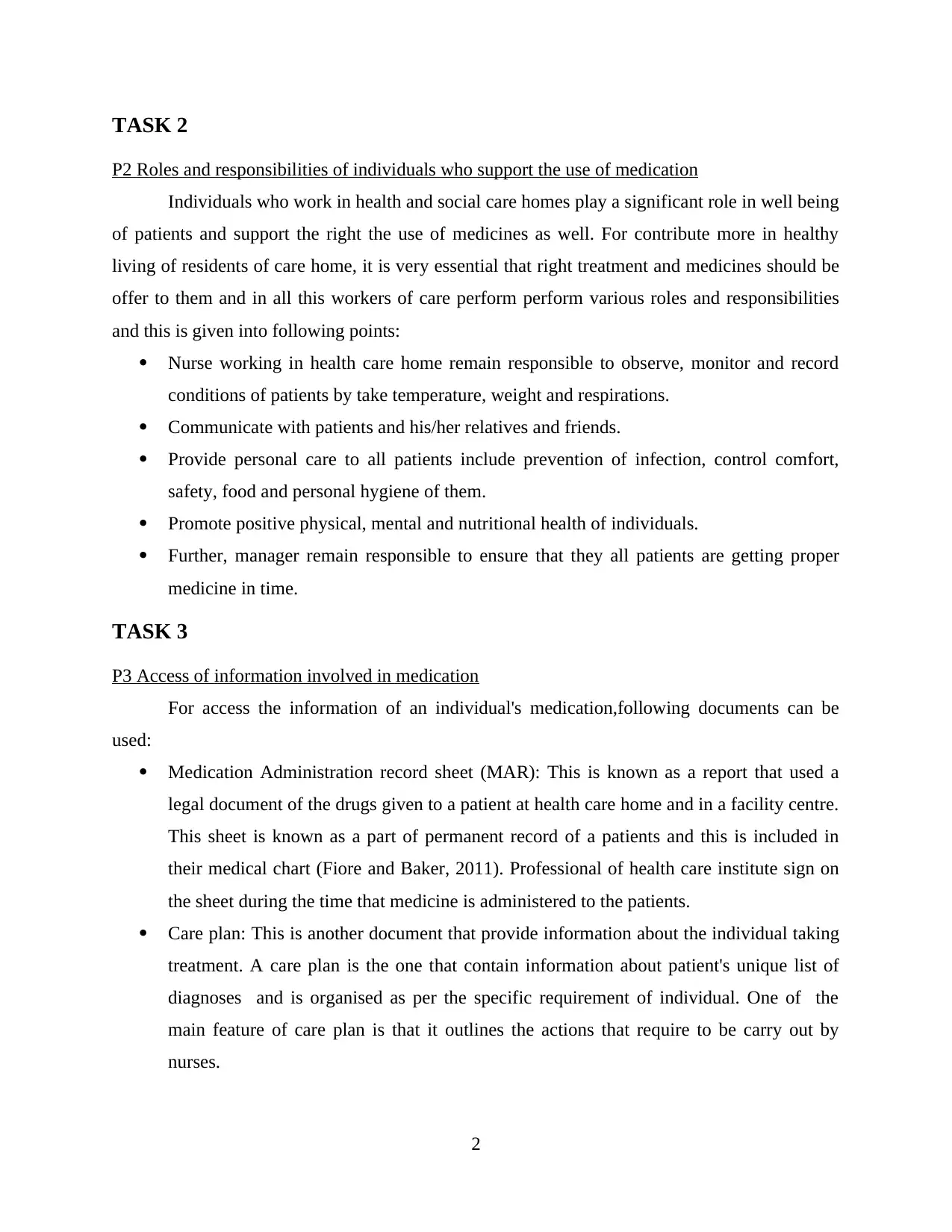
TASK 2
P2 Roles and responsibilities of individuals who support the use of medication
Individuals who work in health and social care homes play a significant role in well being
of patients and support the right the use of medicines as well. For contribute more in healthy
living of residents of care home, it is very essential that right treatment and medicines should be
offer to them and in all this workers of care perform perform various roles and responsibilities
and this is given into following points:
Nurse working in health care home remain responsible to observe, monitor and record
conditions of patients by take temperature, weight and respirations.
Communicate with patients and his/her relatives and friends.
Provide personal care to all patients include prevention of infection, control comfort,
safety, food and personal hygiene of them.
Promote positive physical, mental and nutritional health of individuals.
Further, manager remain responsible to ensure that they all patients are getting proper
medicine in time.
TASK 3
P3 Access of information involved in medication
For access the information of an individual's medication,following documents can be
used:
Medication Administration record sheet (MAR): This is known as a report that used a
legal document of the drugs given to a patient at health care home and in a facility centre.
This sheet is known as a part of permanent record of a patients and this is included in
their medical chart (Fiore and Baker, 2011). Professional of health care institute sign on
the sheet during the time that medicine is administered to the patients.
Care plan: This is another document that provide information about the individual taking
treatment. A care plan is the one that contain information about patient's unique list of
diagnoses and is organised as per the specific requirement of individual. One of the
main feature of care plan is that it outlines the actions that require to be carry out by
nurses.
2
P2 Roles and responsibilities of individuals who support the use of medication
Individuals who work in health and social care homes play a significant role in well being
of patients and support the right the use of medicines as well. For contribute more in healthy
living of residents of care home, it is very essential that right treatment and medicines should be
offer to them and in all this workers of care perform perform various roles and responsibilities
and this is given into following points:
Nurse working in health care home remain responsible to observe, monitor and record
conditions of patients by take temperature, weight and respirations.
Communicate with patients and his/her relatives and friends.
Provide personal care to all patients include prevention of infection, control comfort,
safety, food and personal hygiene of them.
Promote positive physical, mental and nutritional health of individuals.
Further, manager remain responsible to ensure that they all patients are getting proper
medicine in time.
TASK 3
P3 Access of information involved in medication
For access the information of an individual's medication,following documents can be
used:
Medication Administration record sheet (MAR): This is known as a report that used a
legal document of the drugs given to a patient at health care home and in a facility centre.
This sheet is known as a part of permanent record of a patients and this is included in
their medical chart (Fiore and Baker, 2011). Professional of health care institute sign on
the sheet during the time that medicine is administered to the patients.
Care plan: This is another document that provide information about the individual taking
treatment. A care plan is the one that contain information about patient's unique list of
diagnoses and is organised as per the specific requirement of individual. One of the
main feature of care plan is that it outlines the actions that require to be carry out by
nurses.
2

Medical record: This indicate all medical documents of an individual that reveals hi/her
medical history across time with a specific health and social care home.
P4 Routes to administer the medication
Various routes are there to administer the medication as given into following points:
Oral: In this, swallowed by mouth as a liquid, capsule or tablet.
Inhalation: Under this a patients breathed with help of a mask or tube.
Injection: In this a liquid is putting into body of an individual with help of using a needle
and syringe.
Infusion: This is another form of administer the medication, in this, medicine is injected
into a vein with an IV line and then slowly dripped over the time.
Topical: This type of medication is directly apply to the skin.
Installation: In this ear, eye and nose drops are given to the patient.
Rectal: This is inserted into the body part.
P5 Various forms to present the medication
Different forms of present the medication are there given under following points:
Solid: This is one of the most popular form of medication (Fisher and et. al., 2012).
Under this power, tablets, capsules, pills, pellets and pessaries are given to the patient.
Liquid: This is another form of present the medication, in this, syrups, drops, insulin and
suspensions are given to the patient. Suspensions can be in the form of emulsions, gels,
magmas and mixtures are used.
Gas: Spray and oxygen is used by health and social care homes to provide treatment to
patient.
Topical: This form of medication involve use of lotions, creams and transdermal.
P6 Assist the equipment in administration of medication
Health and social care homes use various equipment to offer effective medical treatment
to patients and to contribute more in their healthy living. Equipments used by health and social
care homes can be better understood by following points:
Medicine cup: This equipment is used by health and social care homes for administer oral
treatment and used to determine the liquid medications.
3
medical history across time with a specific health and social care home.
P4 Routes to administer the medication
Various routes are there to administer the medication as given into following points:
Oral: In this, swallowed by mouth as a liquid, capsule or tablet.
Inhalation: Under this a patients breathed with help of a mask or tube.
Injection: In this a liquid is putting into body of an individual with help of using a needle
and syringe.
Infusion: This is another form of administer the medication, in this, medicine is injected
into a vein with an IV line and then slowly dripped over the time.
Topical: This type of medication is directly apply to the skin.
Installation: In this ear, eye and nose drops are given to the patient.
Rectal: This is inserted into the body part.
P5 Various forms to present the medication
Different forms of present the medication are there given under following points:
Solid: This is one of the most popular form of medication (Fisher and et. al., 2012).
Under this power, tablets, capsules, pills, pellets and pessaries are given to the patient.
Liquid: This is another form of present the medication, in this, syrups, drops, insulin and
suspensions are given to the patient. Suspensions can be in the form of emulsions, gels,
magmas and mixtures are used.
Gas: Spray and oxygen is used by health and social care homes to provide treatment to
patient.
Topical: This form of medication involve use of lotions, creams and transdermal.
P6 Assist the equipment in administration of medication
Health and social care homes use various equipment to offer effective medical treatment
to patients and to contribute more in their healthy living. Equipments used by health and social
care homes can be better understood by following points:
Medicine cup: This equipment is used by health and social care homes for administer oral
treatment and used to determine the liquid medications.
3
⊘ This is a preview!⊘
Do you want full access?
Subscribe today to unlock all pages.

Trusted by 1+ million students worldwide
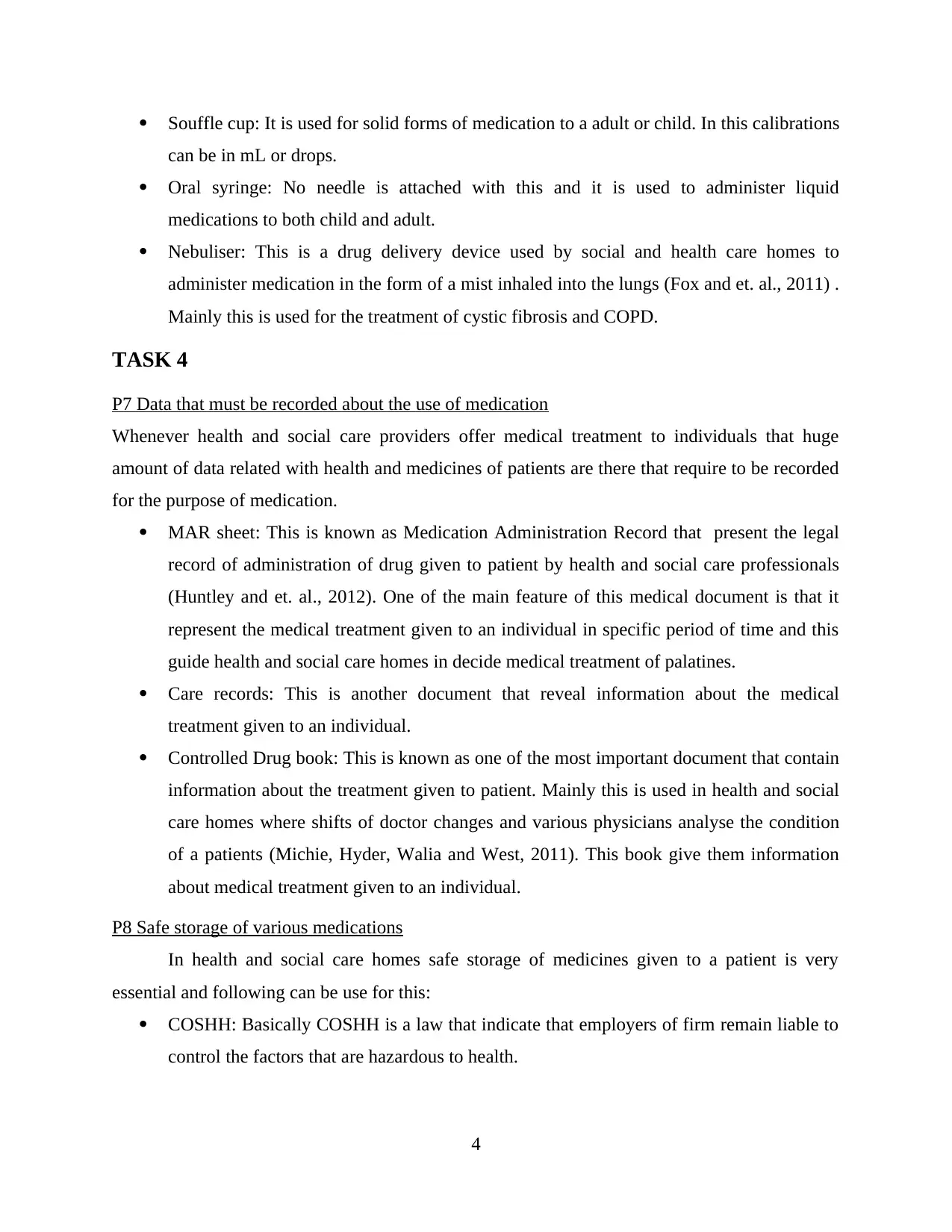
Souffle cup: It is used for solid forms of medication to a adult or child. In this calibrations
can be in mL or drops.
Oral syringe: No needle is attached with this and it is used to administer liquid
medications to both child and adult.
Nebuliser: This is a drug delivery device used by social and health care homes to
administer medication in the form of a mist inhaled into the lungs (Fox and et. al., 2011) .
Mainly this is used for the treatment of cystic fibrosis and COPD.
TASK 4
P7 Data that must be recorded about the use of medication
Whenever health and social care providers offer medical treatment to individuals that huge
amount of data related with health and medicines of patients are there that require to be recorded
for the purpose of medication.
MAR sheet: This is known as Medication Administration Record that present the legal
record of administration of drug given to patient by health and social care professionals
(Huntley and et. al., 2012). One of the main feature of this medical document is that it
represent the medical treatment given to an individual in specific period of time and this
guide health and social care homes in decide medical treatment of palatines.
Care records: This is another document that reveal information about the medical
treatment given to an individual.
Controlled Drug book: This is known as one of the most important document that contain
information about the treatment given to patient. Mainly this is used in health and social
care homes where shifts of doctor changes and various physicians analyse the condition
of a patients (Michie, Hyder, Walia and West, 2011). This book give them information
about medical treatment given to an individual.
P8 Safe storage of various medications
In health and social care homes safe storage of medicines given to a patient is very
essential and following can be use for this:
COSHH: Basically COSHH is a law that indicate that employers of firm remain liable to
control the factors that are hazardous to health.
4
can be in mL or drops.
Oral syringe: No needle is attached with this and it is used to administer liquid
medications to both child and adult.
Nebuliser: This is a drug delivery device used by social and health care homes to
administer medication in the form of a mist inhaled into the lungs (Fox and et. al., 2011) .
Mainly this is used for the treatment of cystic fibrosis and COPD.
TASK 4
P7 Data that must be recorded about the use of medication
Whenever health and social care providers offer medical treatment to individuals that huge
amount of data related with health and medicines of patients are there that require to be recorded
for the purpose of medication.
MAR sheet: This is known as Medication Administration Record that present the legal
record of administration of drug given to patient by health and social care professionals
(Huntley and et. al., 2012). One of the main feature of this medical document is that it
represent the medical treatment given to an individual in specific period of time and this
guide health and social care homes in decide medical treatment of palatines.
Care records: This is another document that reveal information about the medical
treatment given to an individual.
Controlled Drug book: This is known as one of the most important document that contain
information about the treatment given to patient. Mainly this is used in health and social
care homes where shifts of doctor changes and various physicians analyse the condition
of a patients (Michie, Hyder, Walia and West, 2011). This book give them information
about medical treatment given to an individual.
P8 Safe storage of various medications
In health and social care homes safe storage of medicines given to a patient is very
essential and following can be use for this:
COSHH: Basically COSHH is a law that indicate that employers of firm remain liable to
control the factors that are hazardous to health.
4
Paraphrase This Document
Need a fresh take? Get an instant paraphrase of this document with our AI Paraphraser
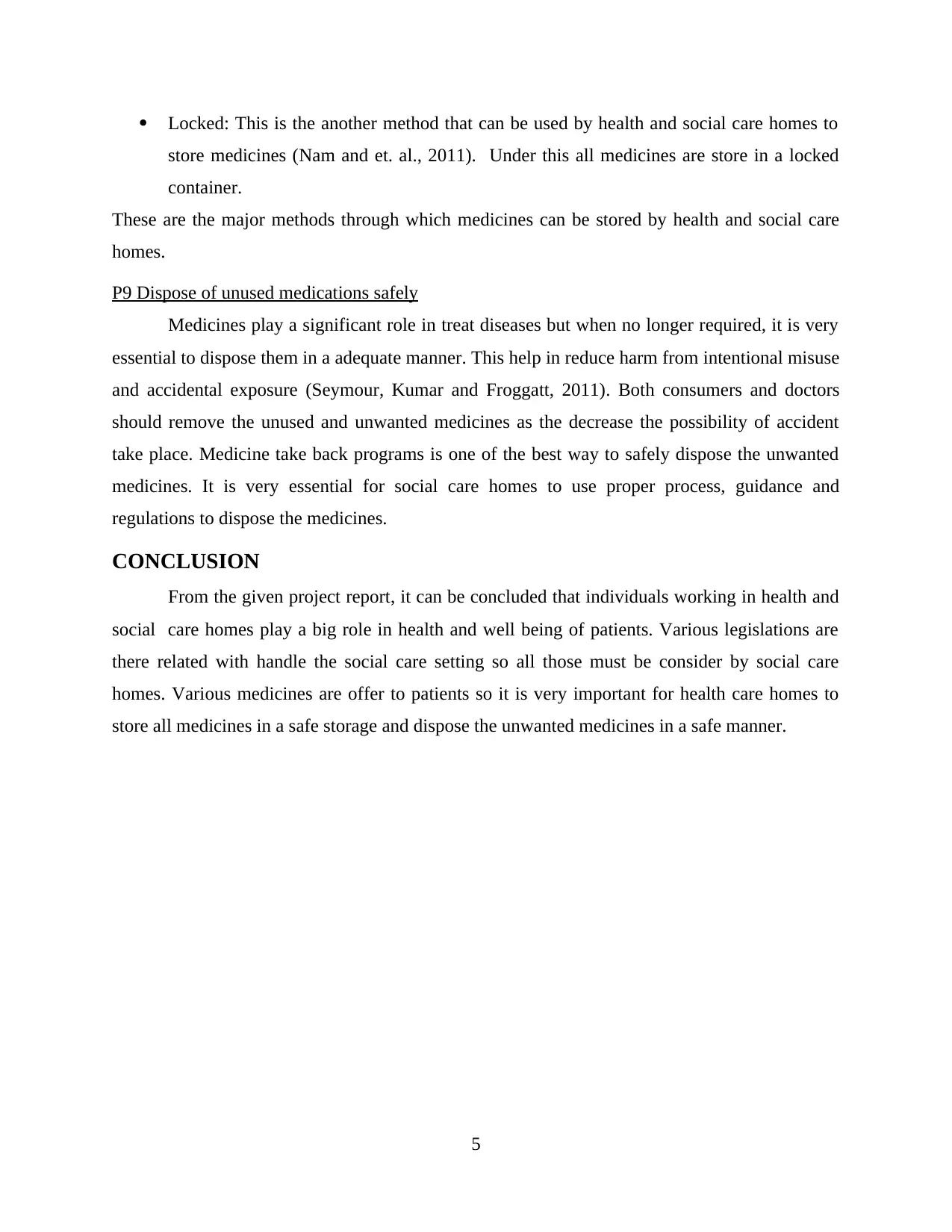
Locked: This is the another method that can be used by health and social care homes to
store medicines (Nam and et. al., 2011). Under this all medicines are store in a locked
container.
These are the major methods through which medicines can be stored by health and social care
homes.
P9 Dispose of unused medications safely
Medicines play a significant role in treat diseases but when no longer required, it is very
essential to dispose them in a adequate manner. This help in reduce harm from intentional misuse
and accidental exposure (Seymour, Kumar and Froggatt, 2011). Both consumers and doctors
should remove the unused and unwanted medicines as the decrease the possibility of accident
take place. Medicine take back programs is one of the best way to safely dispose the unwanted
medicines. It is very essential for social care homes to use proper process, guidance and
regulations to dispose the medicines.
CONCLUSION
From the given project report, it can be concluded that individuals working in health and
social care homes play a big role in health and well being of patients. Various legislations are
there related with handle the social care setting so all those must be consider by social care
homes. Various medicines are offer to patients so it is very important for health care homes to
store all medicines in a safe storage and dispose the unwanted medicines in a safe manner.
5
store medicines (Nam and et. al., 2011). Under this all medicines are store in a locked
container.
These are the major methods through which medicines can be stored by health and social care
homes.
P9 Dispose of unused medications safely
Medicines play a significant role in treat diseases but when no longer required, it is very
essential to dispose them in a adequate manner. This help in reduce harm from intentional misuse
and accidental exposure (Seymour, Kumar and Froggatt, 2011). Both consumers and doctors
should remove the unused and unwanted medicines as the decrease the possibility of accident
take place. Medicine take back programs is one of the best way to safely dispose the unwanted
medicines. It is very essential for social care homes to use proper process, guidance and
regulations to dispose the medicines.
CONCLUSION
From the given project report, it can be concluded that individuals working in health and
social care homes play a big role in health and well being of patients. Various legislations are
there related with handle the social care setting so all those must be consider by social care
homes. Various medicines are offer to patients so it is very important for health care homes to
store all medicines in a safe storage and dispose the unwanted medicines in a safe manner.
5

REFERENCES
Books and Journals
Altice, F. L. and et. al., 2010. Treatment of medical, psychiatric, and substance-use
comorbidities in people infected with HIV who use drugs. The Lancet. 376(9738).
pp.367-387.
Bandelow, B. and et. al., 2012. Guidelines for the pharmacological treatment of anxiety
disorders, obsessive–compulsive disorder and posttraumatic stress disorder in primary
care. International journal of psychiatry in clinical practice. 16(2). pp.77-84.
Fiore, M. C. and Baker, T. B., 2011. Treating smokers in the health care setting. New England
Journal of Medicine. 365(13). pp.1222-1231.
Fisher, E. B. and et. al., 2012. Peer support for self-management of diabetes improved outcomes
in international settings. Health affairs. 31(1). pp.130-139.
Fox, C. and et. al., 2011. Anticholinergic medication use and cognitive impairment in the older
population: the medical research council cognitive function and ageing study. Journal of
the American Geriatrics Society. 59(8). pp.1477-1483.
Huntley, A. L. and et. al., 2012. Measures of multimorbidity and morbidity burden for use in
primary care and community settings: a systematic review and guide. The Annals of
Family Medicine. 10(2). pp.134-141.
Michie, S., Hyder, N., Walia, A. and West, R., 2011. Development of a taxonomy of behaviour
change techniques used in individual behavioural support for smoking
cessation. Addictive behaviors. 36(4). pp.315-319.
Nam, S. and et. al., 2011. Barriers to diabetes management: patient and provider
factors. Diabetes research and clinical practice. 93(1). pp.1-9.
Seymour, J. E., Kumar, A. and Froggatt, K., 2011. Do nursing homes for older people have the
support they need to provide end-of-life care? A mixed methods enquiry in
England. Palliative Medicine. 25(2). pp.125-138.
Smith, M., Giuliano, M. R. and Starkowski, M. P., 2011. In Connecticut: improving patient
medication management in primary care. Health Affairs. 30(4). pp.646-654.
Online
Health and safety legislations. 2018. [Online] Available
through<https://www.scie.org.uk/publications/guides/guide15/legislation/
otherlegislation/healthandsafetylegislation.asp>./
6
Books and Journals
Altice, F. L. and et. al., 2010. Treatment of medical, psychiatric, and substance-use
comorbidities in people infected with HIV who use drugs. The Lancet. 376(9738).
pp.367-387.
Bandelow, B. and et. al., 2012. Guidelines for the pharmacological treatment of anxiety
disorders, obsessive–compulsive disorder and posttraumatic stress disorder in primary
care. International journal of psychiatry in clinical practice. 16(2). pp.77-84.
Fiore, M. C. and Baker, T. B., 2011. Treating smokers in the health care setting. New England
Journal of Medicine. 365(13). pp.1222-1231.
Fisher, E. B. and et. al., 2012. Peer support for self-management of diabetes improved outcomes
in international settings. Health affairs. 31(1). pp.130-139.
Fox, C. and et. al., 2011. Anticholinergic medication use and cognitive impairment in the older
population: the medical research council cognitive function and ageing study. Journal of
the American Geriatrics Society. 59(8). pp.1477-1483.
Huntley, A. L. and et. al., 2012. Measures of multimorbidity and morbidity burden for use in
primary care and community settings: a systematic review and guide. The Annals of
Family Medicine. 10(2). pp.134-141.
Michie, S., Hyder, N., Walia, A. and West, R., 2011. Development of a taxonomy of behaviour
change techniques used in individual behavioural support for smoking
cessation. Addictive behaviors. 36(4). pp.315-319.
Nam, S. and et. al., 2011. Barriers to diabetes management: patient and provider
factors. Diabetes research and clinical practice. 93(1). pp.1-9.
Seymour, J. E., Kumar, A. and Froggatt, K., 2011. Do nursing homes for older people have the
support they need to provide end-of-life care? A mixed methods enquiry in
England. Palliative Medicine. 25(2). pp.125-138.
Smith, M., Giuliano, M. R. and Starkowski, M. P., 2011. In Connecticut: improving patient
medication management in primary care. Health Affairs. 30(4). pp.646-654.
Online
Health and safety legislations. 2018. [Online] Available
through<https://www.scie.org.uk/publications/guides/guide15/legislation/
otherlegislation/healthandsafetylegislation.asp>./
6
⊘ This is a preview!⊘
Do you want full access?
Subscribe today to unlock all pages.

Trusted by 1+ million students worldwide
1 out of 9
Related Documents
Your All-in-One AI-Powered Toolkit for Academic Success.
+13062052269
info@desklib.com
Available 24*7 on WhatsApp / Email
![[object Object]](/_next/static/media/star-bottom.7253800d.svg)
Unlock your academic potential
Copyright © 2020–2025 A2Z Services. All Rights Reserved. Developed and managed by ZUCOL.





